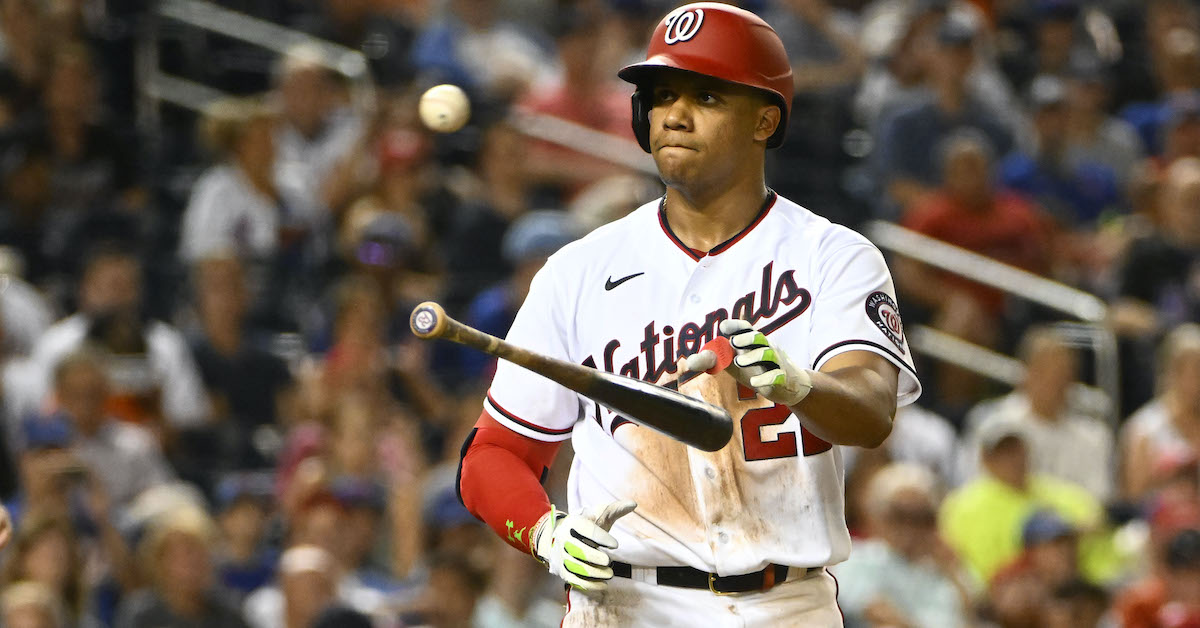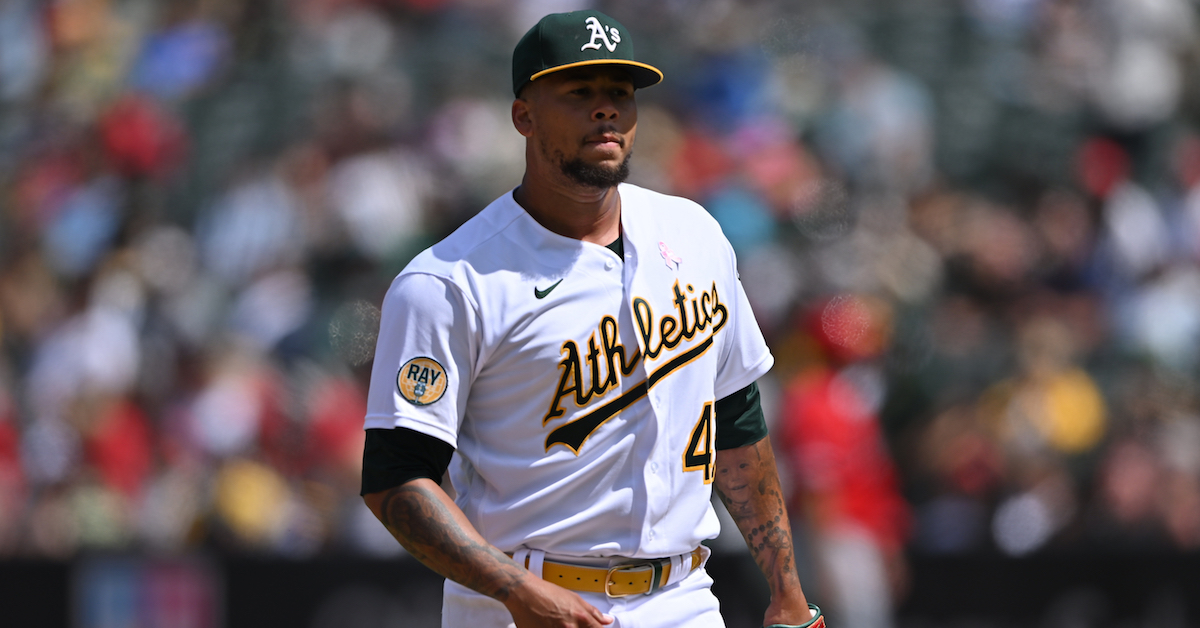Padres Push In All Their Chips, Agree to Deal for Juan Soto and Josh Bell

After months of rumors and loud whispering, the mega-trade for Juan Soto has finally happened, with the winner being the San Diego Padres. It’s hard to overstate the impact of a trade like this; while stars are always traded, Soto is a very young and already quite accomplished player with generational-type talent, and players in that category do not change uniforms by trade all that often. I’m already tempted to type this piece in all capital letters, damaging the eyes of our esteemed editors; the Padres adding an excellent rental in Josh Bell just makes it an even harder test for my willpower.
The stable of talent sent to Washington is impressive, as it should be. Heading to D.C. are starting pitcher MacKenzie Gore, shortstop C.J. Abrams, outfielder Robert Hassell III, outfielder James Wood, pitcher Jarlin Susana, and first baseman Eric Hosmer. For the Nationals, any lingering concerns that someone would have to take Patrick Corbin, thus reducing the value of the return significantly, have now safely evaporated, and they’ll now have to turn to other options there. The Padres even fulfilled Washington’s desire to include a major leaguer who can help the team win games right now in the form of Gore. There are still issues to iron out with Hosmer’s no-trade clause, but for now, we’re going to look at this trade with the assumption that this works out, one way or the other. One possibility is an effort to get a third team into the mix, one that is interested in Hosmer’s services and not on his no-trade list, or at least a team he’d be more willing to waive the clause to join. Who that would be exactly is a tricky question; maybe the Royals?
UPDATE: Hosmer has officially vetoed his move to Washington, though the trade will still go ahead without his involvement. San Diego now has an interesting contract situation to resolve this afternoon.
UPDATE 2: Hosmer is now heading to Boston, per multiple reports, with fellow first baseman Luke Voit now part of the Soto trade in his stead.
UPDATE 3: The deal is now official: Soto and Bell for Voit, Gore, Hassell III, Wood, and Susana.
To wet your whistle — my colleague Ben Clemens will be around shortly with a full rundown of the particulars of this trade, and Eric Longenhagen will run through the prospects — here are some projections which I swear aren’t fan service. (Year-by-year projections for Wood and Susana are unfortunately beyond ZiPS’ scope at this stage of their careers.) Some may be disappointed that Soto’s numbers aren’t quite what they were last year, but his defense looks worse and he’s not quite at his normal level of offense. But considering ZiPS has only “downgraded” his top comp to Carl Yastrzemski, it’s still a great projection!
| Year | BA | OBP | SLG | AB | R | H | 2B | 3B | HR | RBI | BB | SO | SB | OPS+ | DR | WAR |
|---|---|---|---|---|---|---|---|---|---|---|---|---|---|---|---|---|
| 2023 | .284 | .446 | .545 | 517 | 113 | 147 | 29 | 2 | 34 | 104 | 152 | 107 | 14 | 172 | -6 | 6.6 |
| 2024 | .283 | .450 | .550 | 509 | 114 | 144 | 30 | 2 | 34 | 104 | 156 | 110 | 14 | 174 | -7 | 6.6 |
| 2025 | .280 | .453 | .555 | 503 | 115 | 141 | 29 | 2 | 35 | 105 | 160 | 113 | 15 | 176 | -7 | 6.7 |
| 2026 | .277 | .455 | .554 | 495 | 114 | 137 | 28 | 2 | 35 | 103 | 163 | 114 | 13 | 177 | -7 | 6.6 |
| 2027 | .273 | .457 | .551 | 479 | 112 | 131 | 27 | 2 | 34 | 99 | 163 | 112 | 13 | 177 | -8 | 6.4 |
| 2028 | .271 | .453 | .541 | 468 | 107 | 127 | 26 | 2 | 32 | 94 | 156 | 106 | 13 | 173 | -8 | 6.0 |
| 2029 | .269 | .451 | .531 | 450 | 101 | 121 | 24 | 2 | 30 | 89 | 150 | 99 | 12 | 170 | -8 | 5.5 |
| 2030 | .264 | .443 | .516 | 436 | 94 | 115 | 23 | 3 | 27 | 82 | 141 | 93 | 12 | 164 | -9 | 4.8 |
| 2031 | .260 | .432 | .487 | 423 | 85 | 110 | 21 | 3 | 23 | 74 | 128 | 86 | 10 | 153 | -9 | 3.8 |
| 2032 | .257 | .420 | .467 | 405 | 77 | 104 | 19 | 3 | 20 | 67 | 115 | 77 | 9 | 145 | -10 | 2.9 |
| Year | W | L | ERA | G | GS | IP | H | ER | HR | BB | SO | ERA+ | WAR |
|---|---|---|---|---|---|---|---|---|---|---|---|---|---|
| 2023 | 8 | 6 | 4.14 | 30 | 27 | 137.0 | 128 | 63 | 14 | 64 | 135 | 105 | 2.1 |
| 2024 | 8 | 7 | 4.02 | 31 | 28 | 143.3 | 129 | 64 | 15 | 66 | 144 | 108 | 2.3 |
| 2025 | 8 | 6 | 3.96 | 30 | 27 | 141.0 | 124 | 62 | 14 | 63 | 144 | 110 | 2.4 |
| 2026 | 8 | 6 | 3.96 | 27 | 25 | 127.3 | 112 | 56 | 13 | 57 | 130 | 110 | 2.2 |
| 2027 | 7 | 5 | 3.92 | 26 | 24 | 124.0 | 108 | 54 | 13 | 55 | 129 | 111 | 2.1 |
| Year | BA | OBP | SLG | AB | R | H | 2B | 3B | HR | RBI | BB | SO | SB | OPS+ | DR | WAR |
|---|---|---|---|---|---|---|---|---|---|---|---|---|---|---|---|---|
| 2023 | .254 | .308 | .371 | 464 | 68 | 118 | 27 | 0 | 9 | 48 | 27 | 104 | 16 | 80 | 3 | 1.7 |
| 2024 | .261 | .316 | .397 | 448 | 68 | 117 | 28 | 0 | 11 | 50 | 27 | 97 | 16 | 89 | 4 | 2.3 |
| 2025 | .259 | .319 | .403 | 459 | 71 | 119 | 30 | 0 | 12 | 53 | 31 | 105 | 16 | 91 | 4 | 2.5 |
| 2026 | .259 | .320 | .412 | 459 | 72 | 119 | 31 | 0 | 13 | 55 | 32 | 107 | 15 | 94 | 4 | 2.6 |
| 2027 | .259 | .323 | .420 | 459 | 74 | 119 | 32 | 0 | 14 | 57 | 34 | 109 | 15 | 96 | 4 | 2.9 |
| 2028 | .258 | .324 | .419 | 453 | 73 | 117 | 31 | 0 | 14 | 57 | 35 | 110 | 15 | 97 | 4 | 2.9 |
| Year | BA | OBP | SLG | AB | R | H | 2B | 3B | HR | RBI | BB | SO | SB | OPS+ | DR | WAR |
|---|---|---|---|---|---|---|---|---|---|---|---|---|---|---|---|---|
| 2023 | .242 | .301 | .385 | 499 | 67 | 121 | 24 | 1 | 15 | 66 | 41 | 133 | 16 | 82 | -3 | 1.0 |
| 2024 | .247 | .309 | .402 | 478 | 67 | 118 | 25 | 2 | 15 | 67 | 42 | 125 | 16 | 88 | -3 | 1.3 |
| 2025 | .255 | .320 | .429 | 483 | 71 | 123 | 26 | 2 | 18 | 74 | 45 | 122 | 16 | 97 | -3 | 2.0 |
| 2026 | .254 | .323 | .435 | 481 | 73 | 122 | 26 | 2 | 19 | 75 | 48 | 123 | 16 | 100 | -4 | 2.1 |
| 2027 | .255 | .326 | .445 | 479 | 73 | 122 | 27 | 2 | 20 | 76 | 50 | 124 | 15 | 103 | -4 | 2.3 |
| 2028 | .252 | .326 | .436 | 473 | 73 | 119 | 26 | 2 | 19 | 75 | 51 | 123 | 14 | 101 | -4 | 2.1 |
Much more to come.








